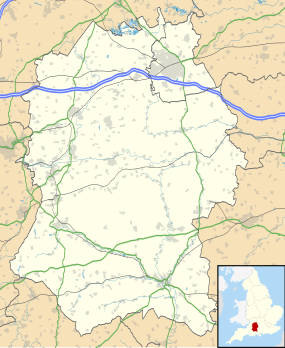Battlesbury Camp

Iron age earth walls and ditch, at the eastern edge of Battlesbury Hillfort
|
|
| Location | Wiltshire |
|---|---|
| Coordinates | 51°12′34″N 2°08′51″W / 51.2095°N 2.1474°W |
| Area | 23.5 acres |
| History | |
| Periods | Bronze Age, Iron Age |
| Site notes | |
| Excavation dates | yes |
| Condition | good |
| Public access | yes |
Battlesbury Camp is the site of an Iron Age bivallate hill fort on Battlesbury Hill in Wiltshire in South West England. Excavations and surveys at the site have uncovered various finds and archaeological data.
Hill forts developed in the Late Bronze and Early Iron Age, roughly the start of the first millennium BC. The reason for their emergence in Britain, and their purpose, has been a subject of debate. It has been argued that they could have been military sites constructed in response to invasion from continental Europe, sites built by invaders, or a military reaction to social tensions caused by an increasing population and consequent pressure on agriculture. The dominant view since the 1960s has been that the increasing use of iron led to social changes in Britain. Deposits of iron ore were located in different places to the tin and copper ore necessary to make bronze, and as a result trading patterns shifted and the old elites lost their economic and social status. Power passed into the hands of a new group of people. Archaeologist Barry Cunliffe believes that population increase still played a role and has stated "[the forts] provided defensive possibilities for the community at those times when the stress [of an increasing population] burst out into open warfare. But I wouldn't see them as having been built because there was a state of war. They would be functional as defensive strongholds when there were tensions and undoubtedly some of them were attacked and destroyed, but this was not the only, or even the most significant, factor in their construction".
Battlesbury occupies the summit of an irregular point of down, with its defences following the natural contours of the hill, and being by nature of the site almost inaccessible on the west and northeast sides. It has triple ditches and ramparts for the most part, with double on the southeast side. The site encloses 23.5 acres in all. There are entrances at the northwest and northwest corners.
Pits found within the fortifications contained late Iron Age pottery, the hub of a chariot wheel, an iron carpenter's saw, a latch-lifter for a hut door, querns, whetstones, sling stones, and animal bones. These all indicate a permanent occupation and date from the 1st century BC. Unfortunately it is suspected that the hills inhabitants came to a violent end, due to the many graves containing men, women and children outside of the northwest entrance. It can only be guessed at whether Roman legions put people to the sword, or if this was the result of intertribal warfare sometime before the Roman conquest.
...
Wikipedia

